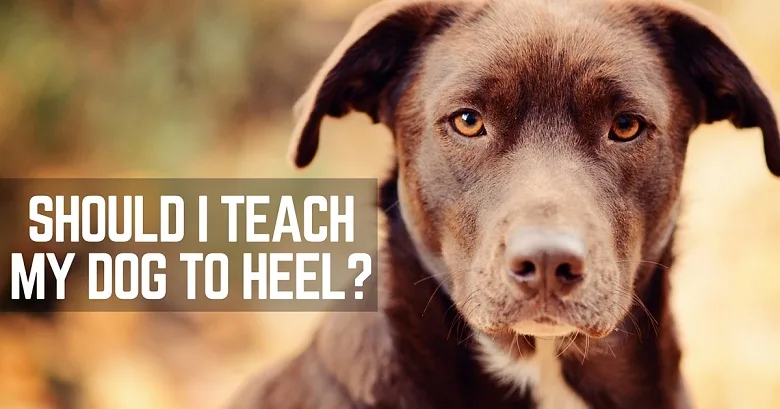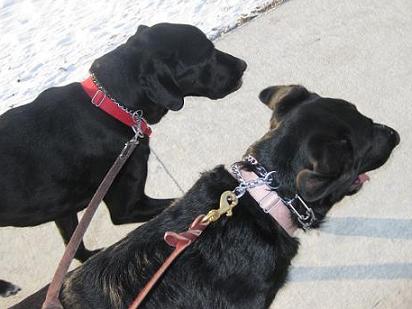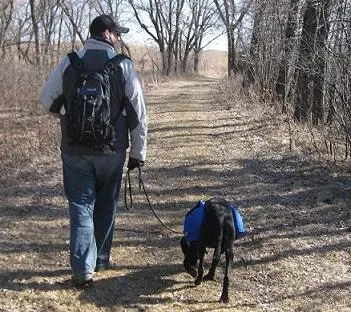Is it best to teach a dog a formal heel command?
A lot of dog owners do not bother teaching their dogs to walk nicely on a leash.
That’s fine.
Some of us might work on this “heeling” or “loose-leash walking” concept part of the time. Half-assed. Maybe we get somewhere or maybe not.
Some people depend on slip collars or anti-pull harnesses. That’s fine, too.
Ace and I have been working on a pretty strict heel for years, meaning my dog is always at my side while on the leash. I say “years” because heeling is always a work in progress. No dog or dog owner will ever be perfect.
A goofy, drooling mutt like mine has the potential to create a lot of chaos. We don’t call him Ace the Crash Test Dummy for nothing.
That’s why Ace is expected to yield to me at doorways. He is expected to walk on a leash without pulling. He is expected to save running and chasing a ball for outside.
This works for us.
I don’t obsess about being “dominant.” I just want a well-mannered dog.

Heel vs. loose leash
To me, “heel” means the dog will walk at my side with her nose even with my leg. The leash is always loose, and the dog knows to pay attention, to copy my pace and to stop if I stop. Heel is a “position” more than an action. It means, be at my left side.
There are very few dogs that actually know how to heel.
Walking on a “loose leash” means the leash should always be loose, but the dog doesn’t have to remain at my side. She might be a step behind. She might be four feet in front. Who cares, as long as she’s not ripping my arm off.

So which is better? “Heel” or “loose leash”?
It really doesn’t matter. Just pick what works for you. Most of us do some combination of the two where “heel” means “just stay generally on my left and not too far ahead.” You have to do what works for you and your dog.
For me, at least at this point in my life, I want Ace and my new pup Remy to obey and understand the heel command. I enjoy traditional obedience training, and I admire the relationship a well-trained dog has with her owner.
I love that no matter where Ace is, I can say, “Ace, heel!” and he walks over and sits at my left side. I love that if we have no leash, he still knows where to be. Remy is not at that point yet. We’re working on it. (Work in progress, remember?)
I also see nothing wrong with allowing a dog to walk ahead on a loose leash for part of every walk or even for the entire walk.
Why should I teach my dog to heel?
A dog that knows how to heel is a dog that is under control. This doesn’t happen by chance. It happens after the owner puts many, many hours into walking, training and bonding with that dog.
A dog that knows how to heel does not appear threatening to other dogs or people. Dogs that are pulling or walking in front usually give off an excited, dominant energy – tail high, ears up. Dogs that are walking calmly beside their owners give off a relaxing energy.
A dog that heels is safe from traffic.
She knows some self control, pays attention to her owner.
A dog that heels is a dog that gets to go along to more places. Walking with her is relaxing, and her leash is never tense. She knows to look to her owner for direction, even under the stress of new surroundings, new people, new smells, new dogs.
A dog that heels is a dog people admire.
How do I teach my dog to heel?
Teaching a dog to heel does not have to be strict. It should be fun.
The concept of heel is often associated with yanking on choke collars or keeping the leash as short and tight as possible.
It doesn’t have to be like that.
I train a dog to heel by teaching her that we do not go anywhere unless she remains at my side. I do not give her the opportunity to get ahead.
No matter what, I hold the leash very lightly in my hand. I should be able to hold it with literally two fingers.
If I hold the leash tight or wrap it several times through my hands, the dog will try to resolve the tension by pulling. If I loosen my grip, the dog relaxes.
Training collars are great tools to give you more confidence and control.
I don’t care what you use – a slip collar, Halti, prong collar, Gentle Leader, shock collar, harness – they all work for certain dogs. I’ve used and recommended each of them.
If you need to correct your dog for sneaking ahead, then correct her with a quick, light pop of the leash. This is not meant to cause fear or pain. Think of it as a tap on the shoulder, something that might cause your dog to think, “Oops! Didn’t mean to get ahead!”
If you are doing your job by remaining calm, staying positive and holding the leash lightly, a slight correction will get your dog’s attention.
And when she’s doing something right, by all means, let her know!
“Wow! What a good heel! Good dog!”
Another trick is to quickly switch directions. Often.
When you walk in a straight line, the dog will focus ahead and try to get to that anonymous smell as fast as she can.
So, change your pace. Walk in circles. Zig-zag. Turn and run the opposite way screaming “Wooooooo! Go, Ace, go!”
You want your dog to have fun!
Also, make sure your dog is getting enough exercise and visiting plenty of new areas. Heeling comes much more naturally if your dog is well socialized and well exercised.
Read my new post: How I’m teaching Remy not to pull.
Why should I teach my dog to walk on a loose leash?
Although I believe teaching a dog to heel is important, the more laid-back concept of loose-leash walking is growing on me.

Humans have bred dogs to do all kinds of work that involves running ahead of us.
We are slow and dogs are fast.
Huskies and malamutes are bred for running ahead and pulling sleds.
Sporting dogs are bred for running ahead to flush, point or retrieve birds.
Shepherds and collies are bred for running ahead to herd and control sheep.
Terriers are bred for running ahead to chase mice, rabbits and other prey or pests.
Most dogs are designed for speed and work.
Why do we get so upset if our dogs have a hard time heeling?
For one thing, it’s about control. There’s a lot of hype about being “dominant” over your dog or being a leader to your dog. A dog that walks ahead of you doesn’t respect you, a trainer might say.
Try not to think of it that way, especially if you’re a control freak. You’ll just end up feeling frustrated with your dog.
My boy Ace is a very submissive dog. It’s clear he sees me as the leader, yet he still pulls on the leash if he gets the chance. And there are plenty of scenarios where he won’t “listen” to me.
Ace is just being a dog. There’s nothing complex about it.
Stop worrying about what everyone else thinks.
Sometimes I worry about what other people think of me and my dog. Do they think I’m training him right?
Who cares.
Forget about that “perfect” dog your friend has. All dogs are perfect sometimes.
Forget about your brother. He just thinks he’s the better trainer.
Forget about what Cesar might do or what any other “expert” might do. You may not see their mistakes, but they still make them.
Every dog is different.
Certain breeds and certain dogs are a lot harder to train than others.
Worry about yourself and what you want from your dog.
Focus on the things your dog does well. He’s probably a very good dog.
If the concept of heel brings out frustration and stress for you and your dog, it’s not worth it. A walk with your dog should always be fun and relaxing. Try the loose-leash walking concept. What’s the big deal?

How do I teach my dog to walk on a loose leash?
Teaching a dog to walk on a loose leash is usually associated with positive reinforcement dog training. The dog can walk ahead, but once the leash is tight, the owner stops. The idea is that the dog goes nowhere unless the leash is loose. It’s a very simple concept, and it works well as long as the owner is consistent.
For some dogs, their favorite treats or toys are the perfect rewards for not pulling. For most dogs, moving forward is enough of a reward.
This means you are going to have to ditch that Flexi, retractable leash for now. Flexi leashes reward dogs for pulling, and since you’ve read this far, I’m assuming you don’t want your dog to pull. Once your dog has mastered loose-leash walking, then maybe the Flexi can work.
If your dog has already mastered the heel command, then walking on a loose leash will take little effort.
All I do is tell Ace “OK!” and he understands he has the freedom to trot ahead, to smell mailboxes, to pee on snowbanks. Every five minutes or so, I tell him “heel” and he is expected to return to my side.
Do you teach your dog to heel?
There’s no right or wrong way to go about dog walking.
The best walks for Ace and I are actually when there is no leash at all – no rules, no worries, no agenda.
Our only goal is to spend time together.
Sign up to receive training tips & more in my weekly newsletter:
Related articles:
How to get my dog to be calm in public

Charlie
Tuesday 27th of March 2018
Great article - great perspective on the whole thing in my opinion. I'm teaching my young student Buck (12 weeks Weimaraner) heel and he's doing pretty well with it. I do sometimes wonder if those habits we're building now might get in the way when we go out and hunt several months from now. For now I am sticking with heel, and just try to get him out into an open field off leash at least once per week. So far he has no compunctions about blasting off into the lead in that situation, which is what I want him to do when we get to that point in his development. At the same time, I do want him to learn self-control. I think that's the major theme with an energetic breed like this. For now I'm betting that my pup is going to be smart enough to know which situation calls for self-control and which calls for boldness in the field. Time will well.
Lindsay Stordahl
Tuesday 27th of March 2018
I think you're right that when he gets out into the field, his instincts will kick in. Sounds like he's going to be an awesome dog!
Chessey
Sunday 6th of August 2017
My 3 year old mastiff, pit, Dane mix is a 100# baby. We work constantly on finessing his heels, in town and at stores he is on a loose leash, at times no leash strict heel, at the park and home area we do a more relaxed heel. I still use his head leader, even though he doesn't need it. If you have a puller, agressive or excitable pup, that's the way to go, you have immediate control of the situation with very little to no muscle.
Lindsay Stordahl
Sunday 6th of August 2017
Yes I recommend the head halter too. Unfortunately it doesn't work for Remy ... He fights it. But it's made a huge difference for me with many other large dogs.
Mariette
Wednesday 21st of December 2016
I love your articles and have been reading them regularly - especially since I have a Golden Retriever (now 8mnths). So here's my issue - In the beginning he pulled like crazy when I put the leash on to take him for a walk. So I changed collars and tried using a harness.. A trainer suggested I use a short leash - which I did.. and I also tried the stop dead technique when he pulls - and it sort of worked... But now when I want to take my puppy out to walk - it's as if he doesn't WANT to go for a walk!! He walks a few metres and then stops.. and he starts to whine and tries to pull me as if to say " I want to go back home!"?? It breaks my heart - cause he's a goldie and should LOVE the idea to go out and walk with his Mommy?? So then I do go back the 50m back to our complex and walk him inside the complex.. and then he seems to be fine??? I really don't understand whether I am doing something wrong or whether I am letting my boy dictate to me?? Please help me with some advice and guidance - I really (ultimately) would love us to run together...
Catherine
Wednesday 14th of December 2016
I have just about overcome Jack's dreadful pulling by using a front leading harness. Now he walks (usually) on a loose leash. But can anyone please help me with his stubbornness? When he decides he wants to go look at something / someone, or he just doesn't want to go where I want, he just stops and digs all four feet into the ground. At 25 kgs I can't shift him. I've tried offering boring treats to tempt him - he either refuses them, spits them out or eats them and still won't budge. With high quality treats, he deliberately keeps stopping just to be tempted with the treat! Then he eats it, walks a pace or two and stops again, glaring at me and refusing to move. Sometimes he lies down and nothing will get him moving. I once tied him up and walked away! 200 metres can take 30 minutes and I end up dragging him through frustration, then I feel terrible. Please help :)
April
Wednesday 14th of December 2016
I love all of the suggestions here. One minute I think we are finally getting somewhere and the next minute Willow is acting like a wild beast. The other day she lunged at a leaf and pulled me into a fire hydrant, stitches and 8 staples in my knee I really have to fix this problem. I use a training harness but maybe I need to try the gentle leader. I walk her 3 to 5 miles a day. If anyone has any other ideas that would be great. Thanks
Lindsay Stordahl
Wednesday 14th of December 2016
Oh I'm so sorry to hear you were hurt. I would try the Gentle Leader or prong (if you haven't already). Maybe a backpack to give her a "job" to focus on and burn some energy.